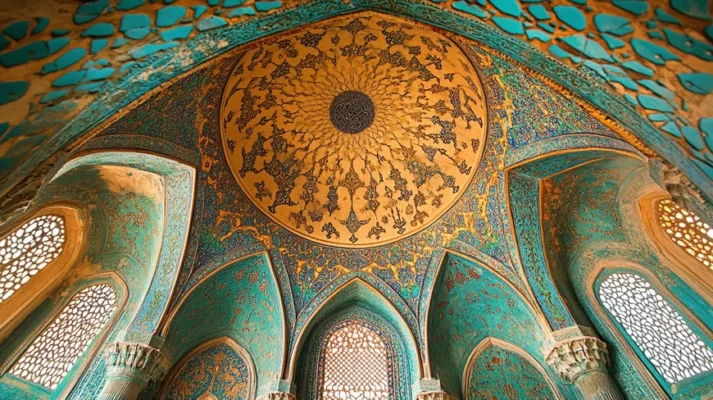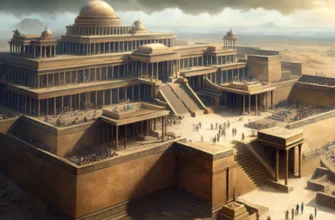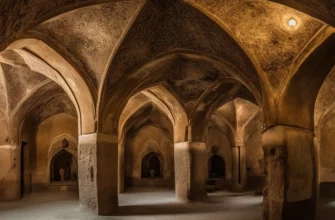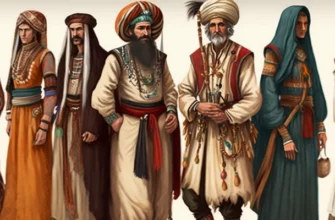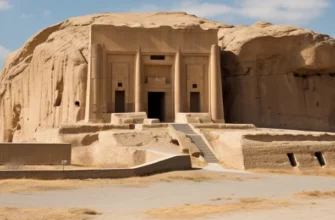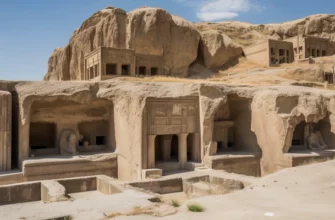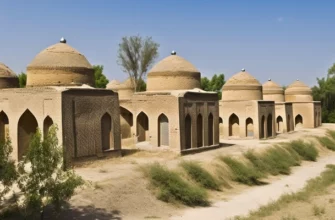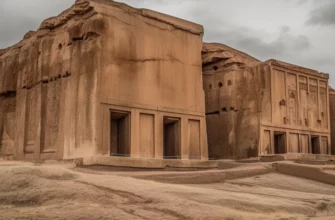Gamadan is one of the oldest cities in Iran, with a rich historical heritage dating back over 2,500 years. Located in the west of the country, it played an important role in the development of ancient Persian civilization. At various times, Hamadan was the capital of several empires, including the Medes, and was of strategic importance in ancient times.
The city is famous for its archaeological sites. One of the most famous is the mausoleum of Esther and Mordechai, sacred to Jews. Gamadan is also known for its ancient ruins, among which you can find the remains of ancient buildings and fortresses.
During the Sassanid Empire, Gamadan was an important cultural and commercial center. Thanks to its geographical location, the city became an important hub on the trade routes connecting the Middle East with Central Asia.
Modern Gamadan retains the atmosphere of ancient history, combining ancient traditions and modern development. The city is an important tourist destination, attracting travelers with its sights, as well as cultural and religious sites.
Gamadan is a city that combines history, culture, and spiritual heritage, leaving an unforgettable impression on everyone who visits it.
- General information about the city of Gamadan
- Historical significance for Iran
- History of Hamadan
- The emergence of the city, the first settlements
- Role in Antiquity and the Sassanid Empire
- Archaeological finds and monuments
- Ancient ruins and archaeological excavations
- The Mausoleum of Esther and Mordecai
- Culture and traditions of Hamadan
- Religious significance
- Conclusion
General information about the city of Gamadan
Gamadan is one of the oldest cities in Iran, located in the west of the country, on the slopes of Mount Elburz.
It is the administrative center of the province of the same name and is an important cultural, historical, and economic center. The city has a rich historical heritage dating back more than 2,500 years and was an important center for various ancient civilizations.
Gamadan is known for its archaeological heritage, as numerous historical monuments dating from various periods, from the Median Empire to the Sassanid period, have been found on its territory. The city is also famous for its important religious sites, including the mausoleum of Esther and Mordechai, which is of great significance to Jews.
Modern Ghamadan is an important economic and commercial center, known for its crafts, such as carpet and textile production. The city also attracts tourists with its historical monuments, natural beauty, and cultural events.
Historical significance for Iran
Gamadan is of great historical importance to Iran, as it has been an important cultural, political, and economic center for thousands of years. The city played a key role in the formation of Iranian civilization and became one of the main centers of ancient empires.
The Median Empire (8th–6th centuries BC)
Gamadan was the capital of the Median Empire, one of the first great civilizations in the territory of modern Iran. The city became an important political center when the Median Empire united various tribes and peoples, laying the foundation for the subsequent flourishing of the Persian Empire.
The Persian Empire and its role in the ancient world
After the fall of the Median Empire, Hamadan remained an important city within the Persian Empire, which became one of the largest and richest civilizations of the time. The city played a role in international trade, political relations, and religious practices.
The Sassanid Empire
During the Sassanid Empire (3rd–7th centuries CE), Hamadan remained an important city, and although the capital was moved to Ctesiphon, the city retained its significance as an important administrative and cultural center.
Importance in a religious context
Hamadan also has great religious significance.
The city has preserved a large number of monuments associated with various religions, including Zoroastrianism and Judaism. The Mausoleum of Esther and Mordecai, located in Hamadan, is an important pilgrimage site for Jews and symbolizes the city’s connection to biblical history.
Contemporary significance
Despite numerous wars and conquests throughout its history, Hamadan has retained its cultural and political role in Iran. Today, the city continues to be an important center of Iranian history, attracting tourists, historians, and researchers from around the world.
History of Hamadan
The history of Hamadan spans over 2,500 years and is one of the oldest and most interesting in Iran. The city has experienced numerous periods of prosperity and decline, leaving behind a wealth of historical and archaeological sites.
Ancient history and foundation
Gamadan was founded during the Median Empire (8th–6th centuries BC) and was originally called Ecbatana. This city became the capital of the Median Empire, which united tribes in the territory of modern Iran and part of Mesopotamia. During this period, Hamadan was an important political and cultural center, and its strategic location on trade routes contributed to the city’s development.
Role in ancient times and the Sassanid Empire
After the fall of the Median Empire, Hamadan remained an important city for Persia. During the Achaemenid Empire (6th–4th centuries BC), the city became an important administrative and commercial center.
However, Gamadan’s greatest prosperity came during the Sassanid Empire (3rd–7th centuries AD), when the city remained an important center in Iran, although the capital of the empire was moved to Ctesiphon.
Islamic period and decline
The Arab conquest of Persia in the 7th century had a significant impact on Hamadan. Although the city remained an important center during Islamic rule, its role in the political life of the country diminished.
During the Middle Ages, the city suffered several devastating attacks and became less important compared to other cities in Iran.
Role in the Middle Ages and the modern period
In the following centuries, Hamadan was part of various dynasties, including the Seljuks and the Hulaguids, but it never returned to its former glory. However, the city retained its cultural and religious significance. One of the most famous monuments of this period is the mausoleum of Esther and Mordechai, which remains an important place of pilgrimage for Jews.
Modern period
Today, Ghamadan has become an important economic, cultural, and tourist center in Iran. The preservation of numerous archaeological sites and the development of infrastructure have made the city popular among tourists and history buffs. Ghamadan remains an important center of Iranian culture and religion, and its history continues to draw attention to the city’s importance for the development of Iran.
Ghamadan is a city that preserves the spirit of ancient Persia, maintaining its historical traditions while adapting to modern challenges.
The emergence of the city, the first settlements
The emergence of the city of Hamadan dates back more than 2,500 years, and its history is closely linked to the formation of the Median Empire, one of the first great civilizations in the territory of modern Iran.
The city was founded at a time when the Median tribes were uniting to fight other peoples in the region, and its role as a political, administrative, and cultural center was extremely important.
First settlement and location
Gamadan, originally called Ecbatana, was founded in a strategically advantageous location among the Elburz Mountains, which provided natural protection from enemy attacks. Its location on important trade routes connecting the Middle East with Central Asia also made it an important economic center.
Its convenient geographical location provided access to resources such as copper and iron, as well as control over important trade routes.
The Median Empire and the development of Ecbatana
In the 8th–7th centuries BC, Hamadan became an important city for the Median Empire. The Medes united various tribes and built their capital, Ecbatana, which became one of the largest and most developed cities of its time. Ecbatana was surrounded by strong walls and defensive structures that protected the city from attacks.
The Medes themselves built the city according to a specific architectural plan: they constructed several levels of fortifications, each level higher than the previous one, which made the city well protected. At the same time, Gamadan began to actively develop in terms of culture and trade, and also became an important religious center.
Thanks to its location and status as the capital of the Median Empire, Ecbatana quickly became one of the most influential cities in Western Asia. Rich archives were kept here, and important political meetings were held. This city became a symbol of the power and greatness of the Median Empire and played a significant role in the political processes of that time.
Thus, Hamadan was founded on solid historical foundations and became an important cultural and economic center for the Median Empire, leaving a significant mark on its history and development.
Role in Antiquity and the Sassanid Empire
The role of Hamadan in antiquity
After the fall of the Median Empire in the 6th century BC, Hamadan, the former capital of Media, remained an important city within the new great Persian empires, notably the Achaemenid and Seleucid empires.
The Persian Empire of the Achaemenids (6th–4th centuries BC) After King Cyrus the Great destroyed the Median Empire in 550 BC, Hamadan continued to be an important city within the vast Achaemenid Empire. Although the capital was moved to Persepolis, Hamadan retained its importance due to its strategic location on trade routes connecting the Middle East with Central Asia.
During the Achaemenid period, Hamadan was known to be an important economic and cultural center. It also retained its role as a religious center, as Zoroastrianism remained the main religion in Iran. In addition, the city maintained trade links with other major civilizations of the time, including Egypt and Mesopotamia.
Seleucids and Parthians (4th–2nd centuries BC) After the collapse of the Achaemenid Empire, Hamadan fell under the rule of the Hellenistic Seleucid Empire and later under the control of the Parthian Empire. During the reign of these rulers, the city remained an important strategic point at the crossroads of trade and military routes between the East and West. However, its importance to these empires was less significant than during the times of the Medes or the Achaemenids.
Ghamadan during the Sassanid Empire
Ghamadan once again became an important center during the Sassanid Empire (3rd–7th centuries AD), when Iran experienced its second golden age and became one of the largest empires of the time. During the reign of the Sassanid dynasty (224–651), the city regained its importance due to its strategic location and economic and cultural opportunities.
Ghamadan as an important administrative center Although the capital of the Sassanids was located in Ctesiphon, Ghamadan played an important role in the political and administrative life of the empire. The city was part of a large network of cities and fortresses that ensured the stability of the empire and served as important points for military and trade caravans.
Cultural and religious significance During this period, Hamadan also retained its importance as a cultural center where literature, science, and the arts flourished as part of the great Sassanid civilization. In addition, Zoroastrianism, the state religion of the Sassanid Empire, also played an important role in the religious practices of Hamadan.
Trade and economy Thanks to its location on key trade routes, Hamadan actively developed as an economic center. The city served as an important trading hub through which goods passed between Central Asia, Mesopotamia, India, and China.
Decline under Arab rule After the Arab conquest of Persia in the mid-7th century, Hamadan went through a major decline. But its strategic location and cultural heritage helped it stay important, even though it was now under Islamic rule.
Thus, Hamadan was of great importance during the ancient and Sassanid periods, playing the role of an important political, cultural, and economic center of Iran.
Archaeological finds and monuments
Hamadan is a city with a rich archaeological heritage, preserving numerous monuments from different historical periods.
Archaeological finds in this city allow us to reconstruct important moments in its history and give an idea of the development of civilizations in the territory of modern Iran. Here are some of the most significant archaeological finds and monuments of Gamadan:
- The Mausoleum of Esther and Mordechai
One of the most famous archaeological sites is the Mausoleum of Esther and Mordechai, located in Hamadan. It is a place of pilgrimage for Jews and is associated with biblical history. According to legend, Esther, the Jewish queen of Persia, and her uncle Mordechai were buried in this place. The mausoleum, built in the Middle Ages, has become a symbol of Hamadan’s connection to Jewish tradition and an important religious site.
- Ruins of the ancient city of Ecbatana
One of the main archaeological sites is the remains of the ancient city of Ecbatana, which was the capital of the Median Empire. The ruins of this city can be found in Hamadan itself. Archaeologists have discovered the remains of ancient fortifications, palaces, and structures dating back to the Median Empire (8th–6th centuries BC). Of particular significance are the excavations that have uncovered several levels of walls that protected the city, as well as large palaces and buildings decorated with frescoes.
- Alvis Fortress
Alvis Fortress is one of the fortresses dating back to the Sassanid period and located near Hamadan. It was an important military fortification that was strategically important for controlling the territory. The ruins of this fortress also testify to the power and importance of Hamadan as a military center during the Sassanid Empire.
- Shah-Abdul-Azim Archaeological Complex
This complex, located in the vicinity of Hamadan, includes archaeological remains dating back to various periods, including the Persian, Islamic, and Sassanid periods. Numerous artifacts have been found here, including ancient vessels, coins, clay tablets, and household items.
- Caves of Hamadan
There are numerous caves in the vicinity of Hamadan that have been used by humans since ancient times. One such cave is the Alio Cave, where ancient archaeological finds have been discovered, testifying to the life of people in prehistoric times. This also confirms that the territory of Hamadan has been inhabited since ancient times, before the emergence of the city.
- Ancient coins and artifacts
During archaeological excavations in Hamadan, a large number of ancient coins were found, dating back to various periods, including the Achaemenid, Sassanid, and even later eras. These coins are important historical evidence of Hamadan’s economy and cultural ties with other parts of the Ancient East.
- Temple ruins
The remains of several temples have been found in Hamadan, testifying to the religious life of the city in different historical periods. Of particular interest are the remains of Zoroastrian temples, as Zoroastrianism was one of the main religions of the Achaemenid and Sassanid empires.
- Artifacts from the Islamic period
During excavations in the area of modern Hamadan, artifacts from the Islamic era were also found, such as clay tiles, ceramics, and textiles. These finds reflect the religious and cultural life of Hamadan after the Arab conquest of Iran in the 7th century.
The archaeological finds of Hamadan provide a deep insight into its rich historical development. The city was an important center of various civilizations, and its monuments continue to tell the story of Hamadan’s influence on the culture and history of Iran and the entire Middle East.
Ancient ruins and archaeological excavations
With its rich history, Hamadan is a veritable treasure trove of ancient ruins and archaeological excavations that provide insight into the development of the region and its cultural heritage.
The remains of ancient cities, fortifications, palaces, and religious buildings allow us to imagine how the civilizations that inhabited these lands developed, from the Median Empire to the Islamic period. Here are some of the most important archaeological sites and ancient ruins in Hamadan:
- Ruins of the ancient city of Ecbatana
Ecbatana, the capital of the Median Empire (8th–6th centuries BC), is one of the most important archaeological sites in Hamadan. The remains of this city are located directly within the boundaries of modern Hamadan. Archaeologists have discovered fragments of ancient walls, fortifications, and palaces dating back to the Median and Achaemenid empires.
Fortifications and defensive walls: One of the main archaeological finds is the walls of Ecbatana, which were built with several levels of fortifications. Each level was raised to a higher height, which was of strategic importance for defense.
Ruins of palaces: Archaeologists have discovered the remains of palaces that belonged to the Median and Persian rulers. These palaces were probably luxuriously decorated and featured architectural details that testify to the high level of culture and technology of the time.
Damaged frescoes and artifacts: Remains of frescoes and household items such as pottery, tools, and coins testify to the city’s advanced culture.
- Alvis Fortress
The Alvis Fortress, located in the vicinity of Hamadan, is an important archaeological site dating back to the Sassanid period (3rd–7th centuries AD). It is a fortified city that was of strategic importance on the route to Mesopotamia.
Ruins of walls and towers: The fortress was surrounded by strong walls and several defensive towers that provided protection against attacks. The remains of defensive structures discovered by archaeologists testify to the importance of this place as a fortress.
Religious remains: Remains of Zoroastrian temples have been found on the territory of the fortress, emphasizing the importance of religion in the life of the Sassanid state.
- Alio Cave and other caves of Hamadan
The caves of Hamadan are another important archaeological site.
The Alio Cave is one of the most famous, where the remains of ancient settlements have been found.
Cave wall paintings: Ancient rock paintings have been found on the walls of some caves, which probably date back to prehistoric times. These paintings give an idea of what life was like before the first settlements appeared.
Artifacts and bones: Archaeologists have also found animal bones, tools, and other household items that indicate early human settlement in the region.
- Archaeological excavations in the vicinity of Hamadan
In the vicinity of Hamadan, especially in the areas near the modern village of Shah-Abd-Azim, numerous archaeological artifacts dating back to the Islamic, Sassanid, and prehistoric periods have been found.
Coins and ceramics: During excavations, a large number of coins belonging to different historical periods were found, as well as numerous fragments of ceramic products. These artifacts are important for understanding the economic and trade links between Hamadan and other regions.
Religious sites: The remains of temples and religious buildings testify to the religious significance of this region during various historical periods, particularly Zoroastrianism and Islam.
- Ancient market and commercial sites
Archaeological research has also uncovered the remains of ancient markets and trading sites, confirming Gamadan’s importance as a trading center at the crossroads of ancient routes.
Ruins of bazaars: Research at the sites of ancient bazaars and trading warehouses suggests that Hamadan was an important hub for trade caravans passing through Iran.
Archaeological excavations in Hamadan are opening new horizons for understanding the history of this region. Ancient ruins, architectural monuments, and artifacts provide a unique opportunity to study the development of cities and civilizations that have had a significant impact on the history of Iran and the Middle East.
The Mausoleum of Esther and Mordecai
The Mausoleum of Esther and Mordecai is one of the most important historical and religious monuments in Hamadan, which is of great importance to the Jewish community and is an important place of pilgrimage. The mausoleum is associated with the biblical story of Esther, the Jewish queen of Persia, and her uncle Mordecai, heroes of one of the books of the Tanakh, the Book of Esther.
According to the biblical account, Esther was a young Jewish woman who became queen of the Persian king Ahasuerus (Book of Esther). She saved the Jewish people from genocide organized by the evil minister Haman. During this period, Mordecai, Esther’s uncle, played a key role in saving the Jewish people by exposing the conspiracy against the king.
The mausoleum is a symbol of this story and serves as a reminder of the victory of righteousness over evil. Believers believe that Esther and Mordecai are buried here, although historical evidence and archaeological research do not provide conclusive proof of the authenticity of this burial site.
The Mausoleum of Esther and Mordecai is located in the old quarter of Hamadan and is a complex that includes a mausoleum, a mosque, and a shrine, making it an important place not only for the Jewish community but also for Muslims, as the story of Esther and Mordecai also has significance in Islam.
The mausoleum building: The mausoleum consists of a dome and a minaret, which give it a distinctive oriental appearance. It was built in the Persian architectural tradition, with elements characteristic of the period when it was constructed. The entrance to the mausoleum is decorated with carvings and mosaics, emphasizing the religious significance of this place.
Interior: Inside the mausoleum, there are two tombs, probably belonging to Esther and Mordechai. The walls feature texts in Hebrew and Farsi containing prayers and quotations from the biblical Book of Esther. There are often plaques with comments and historical accounts of the lives of these historical figures.
Holy site: The mausoleum is considered a holy site and is very popular among pilgrims, especially during the celebration of Purim, a Jewish holiday dedicated to the victory of Esther and Mordecai over Haman. During the holiday, people from different countries come to the mausoleum to pray and honor the memory of the heroes.
The Mausoleum of Esther and Mordechai is an important symbol of Jewish history and culture and is also of great significance to many religious groups, including Muslims, who also revere Esther as a woman of great courage and wisdom. This place, which unites religions and cultures, serves as a bridge between the different peoples living in Iran.
Gamadan has been and remains an important city for various cultural and religious communities. The mausoleum is part of this multicultural heritage and is a testament to how different civilizations and religions have interacted and left their mark on this land. For the Jewish community, this place has deep emotional and religious significance, and for tourists and pilgrims, it is an important element of their religious journey.
Culture and traditions of Hamadan
With its rich history and cultural heritage, Hamadan is an important center in Iran where different cultural, religious, and ethnic traditions intertwine. The culture of Hamadan reflects the centuries-old influences of Persian, Arab, Jewish, and other cultures that have made this city unique.
- Religious and cultural diversity
Gamadan has a rich cultural mix, including various religious and ethnic groups. Muslims, Jews, and other minorities live here, preserving their cultural traditions.
Islam: The majority of Hamadan’s population is Muslim, mainly Shiites. Islamic traditions and celebrations of important religious events such as Ramadan, Eid al-Fitr, and Eid al-Adha are of great importance in the daily life of the city. During these times, prayers, public events, festivals, and charity events are held.
Jewish community: Hamadan is also home to an ancient Jewish community that dates back to biblical times. Jewish traditions and holidays, including Purim (a holiday commemorating the story of Esther and Mordecai), are actively celebrated in the city, and the mausoleum of Esther and Mordecai is an important pilgrimage site for the Jewish community.
- Music and dance
Music and dance are an important part of Hamadan’s cultural life. Iranian music, particularly traditional Persian music, has deep roots in the city’s history. Musical instruments such as the tar (a stringed instrument), the setar (a plucked instrument), and the daf (a drum) are an integral part of cultural events and celebrations in the city.
Folk dances: Traditional Iranian folk dances performed to music are also part of local celebrations. They reflect the cultural diversity of the region and serve as a means of expressing feelings and joy during celebrations.
- Arts and crafts
Gamadan is famous for its traditional crafts, among which pottery and carpet weaving occupy a special place.
Traditional Persian carpets, made by hand, are of high artistic value and are an important part of the local culture. Pottery making also has a long tradition in Hamadan, and local artisans produce a variety of vessels, vases, and decorative items.
- Gamadan cuisine
Gamadan cuisine combines various influences from Persian and Arabic cuisines and also has its own unique characteristics that reflect the traditions of the Iranian region.
Here are some dishes typical of Hamadan:
Ghosht-kubideh (grilled meat served with rice): a popular dish consisting of minced meat cooked on the grill and served with a variety of side dishes.
Beans: Various dishes made with legumes, especially beans, are also part of the local cuisine.
Spiced pilaf: A dish consisting of rice with aromatic spices and often served with meat or vegetables.
- Holidays and festivals
Gamadan celebrates numerous holidays that have both religious and cultural significance. Here are some of the main holidays celebrated in the city:
Purim: A Jewish holiday celebrated in honor of the salvation of the Jewish people in Persia, according to the biblical story of Esther and Mordecai. During this holiday, religious ceremonies, festive events, and banquets are held in Hamadan.
Ramadan: The month of fasting is an important part of Islamic culture, and during this time, the people of Hamadan participate in nightly prayers and organize charity events and celebrations after sunset.
Flower Festival: This is a seasonal holiday celebrated in the spring when flowers bloom in the city, including roses and other plants. The Flower Festival is marked by concerts, dances, and exhibitions by local artists.
- Architecture and cultural heritage
The architecture of Hamadan also reflects its cultural heritage. The city is famous for its Muslim shrines, ancient mosques, and historic buildings and palaces. These are not only architectural landmarks but also important cultural sites for local residents.
Important architectural landmarks include:
Baba Taher Mosque: One of the oldest and most significant mosques in Hamadan, it is an example of classical Persian architecture.
The Mausoleum of Esther and Mordechai: an important religious and cultural site for the Jewish community, associated with biblical history.
The culture and traditions of Hamadan reflect the rich and diverse history of this city, which preserves the heritage of different peoples and civilizations. The city continues to be an important cultural and religious center of Iran, where the traditions of Persians, Arabs, Jews, and many other peoples intertwine, making it unique in its kind.
Religious significance
Ghamadan is of great religious significance to several religious communities, including Muslims, Jews, and other minorities. The city is an important religious center, home to numerous shrines, temples, and tombs of important historical figures. Here are some aspects of Ghamadan’s religious significance:
- Islamic significance
For Muslims, Hamadan is an important city linked to Iran’s Islamic history. The city is home to several important Islamic shrines and is an important religious center, especially for Shiites, the main religious sect in Iran.
Baba Taher Mosque: This is one of the oldest mosques in Hamadan and is an important architectural and religious landmark. The mosque was built during the Sassanid Empire and is an important place of worship for Muslims.
Islamic celebrations: Hamadan actively participates in religious celebrations such as Ramadan, Eid al-Fitr, and Eid al-Adha. During Ramadan, the city’s residents take part in special prayers and organize charity events for the poor.
- Religious significance for Jews
Gamadan is a holy city for the Jewish community, mainly because of the mausoleum of Esther and Mordechai. This mausoleum is an important pilgrimage site for Jews because it is associated with the biblical story of the salvation of the Jewish people in Persia, described in the Book of Esther.
The Mausoleum of Esther and Mordecai: According to biblical tradition, Esther, a Jewish queen, and her uncle Mordecai became heroes when they saved the Jewish people from genocide organized by the evil minister Haman. This mausoleum is not only an important religious monument but also a symbol of Jewish suffering and liberation.
Purim: Purim is one of the main holidays in the Jewish calendar, commemorating the historical event when Esther and Mordecai saved the Jews from destruction. During this holiday, special prayers and festive events dedicated to their memory are held in Hamadan.
- A place of religious tolerance
Gamadan is an example of religious tolerance, as Muslims, Jews, and other religious communities have coexisted peacefully here throughout its history. The city has become a place where different religions and cultures have been able to preserve their traditions and influence each other’s development.
- A city as a center of spirituality
Gamadan was also known in the past as a center of spiritual education and learning. The city became a hub for Islamic scholars, philosophers, and religious figures who influenced the development of Shiite theology and philosophy in Iran.
- Pilgrimages and holidays
In addition to religious holidays such as Ramadan and Purim, Hamadan is also a destination for numerous pilgrimages. The mausoleum of Esther and Mordechai attracts Jewish pilgrims from various countries, while Islamic shrines such as the Baba Taher Mosque attract Muslims.
- Interfaith heritage
Thanks to its multi-ethnic and multi-faith history, Hamadan has become a symbol of interfaith harmony in Iran. It is a place where the history of religions and cultures intertwine, highlighting its importance not only for Iran but for the entire Middle East.
Ghamadan has deep religious significance for both Muslims and Jews and is also an important place for the preservation of religious tolerance. The city is a center for religious shrines, pilgrimages, and traditions that highlight the richness and diversity of Iran’s spiritual heritage.
Conclusion
With its rich history and cultural heritage, Hamadan occupies one of the most important places in Iran. This city is a living testimony to ancient civilizations, from the Median Empire to modern Iran, and has left a deep mark on the development of Persian culture, religion, and science.
Its archaeological finds, ancient monuments, religious shrines, and cultural traditions make Hamadan a unique center where history, culture, religion, and art intertwine.
As an important cultural and religious center, Hamadan has become home to a variety of ethnic and religious groups, such as Muslims, Jews, and other minorities. Religious shrines, such as the mausoleum of Esther and Mordechai, as well as numerous mosques and temples, highlight the city as a place of spiritual development and pilgrimage.
Gamadan is also an important center for the preservation of traditional crafts, music, dance, and cuisine, which are an integral part of Iran’s cultural heritage. Its influence on the development of Persian literature, science, and philosophy has left a significant mark on the history of Iran.
Thus, Hamadan is not only a key element of Iranian history, but also continues to play an important role in the preservation and development of Iran’s cultural heritage today. The city retains its significance as a symbol of the richness and diversity of Persian civilization, making it important not only for Iran but for the whole world.
